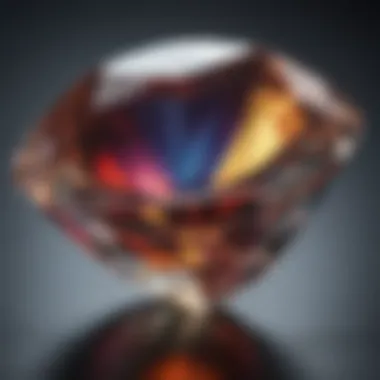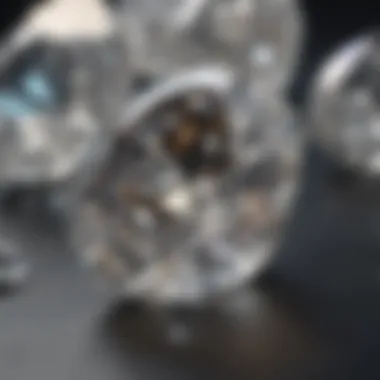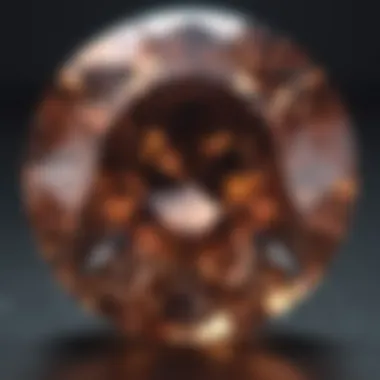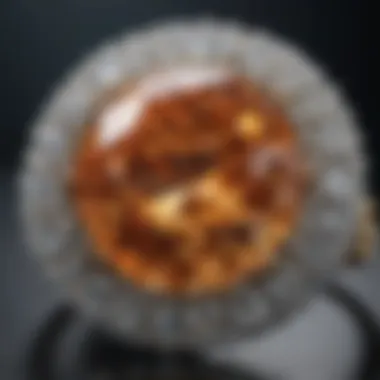A Comprehensive Guide to Diamond Color and Clarity


Intro
In the realm of gemstones, diamond color and clarity stand as two of the most critical factors affecting a diamond's overall valuation and aesthetic appeal. For both enthusiasts and collectors, understanding these attributes provides vital insights into the quality and selection process of diamonds. Mastering the assessment of diamond color and clarity not only enhances one's knowledge but also influences purchasing decisions.
Grading systems, such as the one established by the Gemological Institute of America (GIA), play a leading role in the industry. These criteria influence the market and help buyers make informed choices. Whether one is new to gemstone evaluation or has years of experience under their belt, this comprehensive guide aims to elucidate the crucial points regarding diamond quality.
The journey of assessing diamonds starts with understanding what these attributes mean and how they affect the perception of beauty in each stone. Let's dive deeper into this exploration.
Understanding Diamond Color
Understanding diamond color is crucial in gemstone evaluation. This section explores how color impacts a diamond's appearance and value. Grading systems help determine preferences among gem collectors and enthusiasts. It heavily influences purchase decisions and sentiment in the market. Thus, understanding diamond color lays a foundation for informed buying choices, ensuring satisfaction with the stone for years to come.
Preamble to Diamond Color
Diamond color refers to the presence of hues in what is generally perceived as a clear gemstone. Most diamonds are graded based on their lack of color. The most highly valued diamonds have little to no color, appearing completely clear. A diamond's color can range from a faint yellow or brown to near-colorless. Knowing how to identify and assess these color grades is essential for buyers. This knowledge contributes to making wise decisions when purchasing a diamond, impacting both aesthetics and market value.
The Color Grading Scale
The color grading scale for diamonds is a widely accepted method for evaluating the presence of color in diamonds. This scale is critical for distinguishing between various grades, enabling consumers and professionals alike to articulate their preferences more clearly.
Scale from to Z
The scale ranges from D to Z, with D representing colorless diamonds. Colorless stones are rare and command significantly higher prices. Each letter grade along the scale indicates a slight increase in color presence. As we move towards Z, the amount of yellow or brown visible increases.
A key characteristic of this grading system is its clarity and precision. This systematic approach allows buyers to make comparisons effectively. Being familiar with this scale is a beneficial tool for anyone interested in diamond purchasing. However, the unique feature of this scale is the subjective perception of color in different lighting conditions, which can sometimes make it tricky. Often, diamonds graded G to J fall in the near-colorless category, appealing due to their better affordability without dramatic visual differences from higher grades.
Defining the Difference Between Grades
Defining the difference between grades on the diamond color scale is essential for understanding the nuances in value and appearance. Each grade represents a slight variance in color, yet these differences can impact the overall desirability.
One of the important characteristics of understanding these differences is the financial implications. A diamond graded D carries a premium price compared to one graded H. Recognizing these differences helps buyers comprehend their options within their budget. Therefore, knowing this information empowers buyers to make more informed decisions. Another unique aspect to consider is the subjective nature of how individuals perceive color. Grading may sometimes depend on personal preference, combining technical analysis with aesthetic enjoyment.
Factors Influencing Color Perception
Several factors can influence how color in diamonds is perceived. It is important for buyers to understand these influences for making an informed choice.
Lighting Conditions
Lighting conditions are an essential factor when assessing a diamond's color. Different types of light, such as natural sunlight, incandescent light, or fluorescent light, can significantly change perceived color. Diamonds may appear warmer under yellow-toned light and cooler in bluish light.
This aspect is key for anyone purchasing a diamond. Understanding lighting conditions can impact how a diamond looks on oneself versus in a shop. Buyers should consider viewing stones under various lighting to ensure their expectations meet all possible scenarios.
Background Colors
Background colors contribute to color perception in diamonds. When a diamond is placed against a colored background, the hues of that background can enhance or diminish the diamond's apparent color. For example, a white cloth can make a diamond appear more colorless than when placed on a darker surface.
Recognizing this influence is important for buyers. It helps them visualize how various settings and backgrounds will affect the overall look of the diamond. This awareness ensures a buyer selects a diamond that aligns perfectly with their vision, whether for personal use or as a gift.


Influence of Color on Value
The connection between color and value is significant in diamond pricing. Diamonds that are more colorless are generally more desirable and, therefore, more expensive. Understanding this correlation helps buyers navigate the market effectively.
As value is closely tied to color grade, diamonds with lower colors may not be a good investment if the buyer wishes to sell or upgrade in the future. Buyers should weigh their options carefully, considering whether they prioritize aesthetics or value retention when assessing diamonds.
Exploring Diamond Clarity
Understanding the clarity of diamonds is essential in gemstone evaluation. It focuses on identifying imperfections and the overall quality of a diamond. Clarity impacts the visual appeal and market value of the stone. When assessing a diamond, higher clarity translates to more brilliance and fire.
By grasping the nuances of clarity, buyers can make informed decisions that align with their taste and budget. This part of the guide offers insights that are valuable for both experienced collectors and novices in the world of diamonds.
Defining Clarity
Clarity refers to the absence of imperfections in a diamond. These imperfections can include internal flaws, known as inclusions, and external blemishes. Clarity is a critical factor, as it directly influences how light interacts with the stone. A diamond with high clarity appears more brilliant and has greater sparkle.
While both inclusions and blemishes may be present, their visibility determines the clarity grade. Understanding clarity allows buyers to appreciate the levels of quality within the diamonds they consider.
The Clarity Grading Scale
Diamonds are graded on a scale that ranges from Flawless to Included. This grading system helps communicate the quality of a diamond’s clarity. Each grade has distinct characteristics, outlining the extent of imperfections present.
Categories: Flawless to Included
The categories range from Flawless to Included, with several grades in between. A Flawless diamond contains no inclusions or blemishes visible under 10x magnification. This quality makes Flawless diamonds highly sought after and valuable. In contrast, Included diamonds contain noticeable flaws that are visible to the naked eye, significantly affecting their value.
Choosing between these categories is crucial. Many buyers may desire higher grades for maximum brilliance, but understanding the balance between imperfection and price is also important.
Understanding Each Grade
Each grade carries specific definitions, which help buyers gauge their preferences. For instance, Very Slightly Included diamonds can contain minor inclusions that are difficult to detect. These may be an attractive option for those seeking a balance of quality and cost. Knowing these details allows buyers to navigate choices more efficiently.
Overall, understanding the grading scale aids in making confident selections tailored to individual requirements and budgets.
Common Clarity Characteristics
Identifying common clarity characteristics helps define the quality of diamonds. Inclusions and blemishes are two main elements that influence the clarity grade. Distinguishing these features enhances buyers' knowledge when evaluating potential purchases.
Types of Inclusions
Inclusions are internal imperfections that can encompass various forms, such as crystals or clouds. Some inclusions may even resemble feathers or needles. Each type of inclusion affects the diamond's performance and appearance. Buyers often prefer few or no inclusions to maintain a clean image in the stone.
Moreover, while minor inclusions may go unnoticed, their presence can impact the overall market value. Therefore, understanding these differences is crucial.
Types of Blemishes
Blemishes are external flaws that include scratches or nicks on the diamond's surface. They can also have an impact on clarity, but they are generally less concerning than inclusions. Buyers should examine the diamond closely, ensuring the blemishes do not detract from its beauty.
Overall, awareness of blemishes complements understanding clarity, ultimately leading to more informed purchasing decisions.


Effects of Clarity on Brilliance
Clarity plays a vital role in determining a diamond’s brilliance. A higher clarity grade typically means less light absorption, resulting in enhanced sparkle. In essence, clarity not only influences appearance but also plays a part in the diamond's longevity. Discerning buyers can enhance their selection process by prioritizing clarity along with color and cut.
The GIA Grading System
The Gemological Institute of America (GIA) grading system stands as a hallmark of reliability and credibility in the diamond industry. Understanding this system is crucial for buyers, as it directly impacts the valuation of diamonds and ensures transparency in gemstone transactions. The GIA's rigorous standards help buyers make informed choices and protect their investments. In this section, we will explore the significance of the GIA grading system and how it affects the world of diamonds.
Overview of the Gemological Institute of America
The Gemological Institute of America is a nonprofit organization dedicated to research and education in the field of gemology. Founded in 1931, GIA has played a pivotal role in establishing universal grading standards for diamonds. This includes the well-known 4Cs: Color, Clarity, Cut, and Carat weight.
GIA's grading reports are recognized globally by jewelers and gem enthusiasts. Their dedicated work has contributed to a greater understanding of diamonds, thus enabling consumers to make educated choices. The organization emphasizes ethical standards in gemstone sourcing, aiming to create a responsible industry.
Significance of GIA Certification
GIA certification is invaluable for both buyers and sellers. A GIA-certified diamond comes with an official grading report that outlines its specific attributes. This report includes detailed information about the diamond's color and clarity, along with other essential metrics.
The benefits of GIA certification include:
- Credibility: GIA is recognized as the most trusted entity for diamond grading. Its certifications are widely accepted and respected.
- Valuation Assurance: Knowing that a diamond is graded by GIA provides confidence regarding its market value. This is especially vital for significant purchases.
- Resale Potential: Diamonds with GIA certification often retain their value better than those without. They can be sold more easily if their quality is documented.
Interpreting GIA Reports
Understanding how to read GIA reports is essential for anyone looking to purchase a diamond. Each report contains specific details that provide insight into the diamond's quality. It includes:
- Grading Results: The primary features such as color grade, clarity grade, cut grade, and carat weight.
- Detailed Descriptions: Information on inclusions and blemishes that may affect clarity, as well as additional notes on the diamond's unique characteristics.
- Proportional Data: Measurements that help assess the diamond’s overall proportions, which influence its appearance and brilliance.
Interpreting these reports allows buyers to compare diamonds on a level playing field, fostering informed decision-making.
"A GIA grading report is not just a piece of paper; it is a ticket to understanding and navigating the diamond market with confidence."
By grasping the significance of the GIA grading system and reports, buyers can further appreciate the subtleties of diamond quality. This knowledge empowers them to make wise investments while pursuing their ideal gemstone.
Practical Considerations for Buyers
Understanding the practical aspects of purchasing a diamond is crucial for any buyer. A diamond is not just a piece of jewelry; it is an investment. Therefore, carefully considering your choices will lead to satisfaction and value retention over time. In this section, we will explore several practical considerations that one should keep in mind when buying a diamond. This guidance will help buyers make informed decisions.
Setting a Budget
Setting a realistic budget is often the first step in the diamond buying process. A budget helps to narrow down options and avoid impulsive decisions. The price of diamonds can vary significantly based on color, clarity, carat weight, and cut. Buyers should establish a clear budget based on their personal financial situation and desired characteristics in a diamond.
A well-defined budget encourages focused research and shopping. It also prevents disappointment when unrealistic expectations collide with market realities. Buyers can stay within their means and possibly allow for adjustments later if they find exceptional options within their price range.
What to Look for in a Diamond
When buying a diamond, two crucial elements often stand out: color preference and desired clarity level.


Color Preference
Color preference refers to the buyer's subjective taste regarding the diamond's color. While the grading scale goes from D (colorless) to Z (light yellow), most buyers gravitate towards the D-F range due to their aesthetic appeal. Colorless diamonds tend to reflect light better and display a higher value.
A key characteristic of color preference is that it is personal. Some buyers may prefer the warmer hues of G or H colors, which are still high quality but may be less costly. This choice is beneficial as it allows for flexibility in budget allocation. The unique feature of color preference is that it can differentiate a diamond in terms of charm, allowing each stone to express individuality. However, it is essential to weigh preferences against market prices to ensure satisfaction with the purchase.
Desired Clarity Level
Desired clarity level relates to the absence of inclusions or blemishes in a diamond. The clarity grading scale ranges from Flawless to Included. Higher clarity usually means better brilliance and value. A clarity level of VS1 or VS2 offers a good balance between quality and affordability.
The key characteristic of desired clarity level contributes significantly to the overall appearance of the diamond. Higher clarity grades often result in a sparkling look that captivates the eye. This choice is particularly appealing to buyers who prioritize visual impact. The unique feature of desired clarity lies in its influence on light performance, making it a vital aspect to consider. However, excellent clarity may come at a higher price, so buyers should assess their priorities carefully.
Making Informed Choices
Making informed choices requires diligent analysis and understanding of available options. It is essential to evaluate every element of a diamond to maximize value.
Comparative Analysis of Options
Comparative analysis of options involves assessing various diamonds based on the buyer's criteria. This process can reveal differences that might not be apparent at first glance. Buyers are encouraged to compare diamonds across several attributes, such as color, clarity, cut, and price.
One notable aspect of comparative analysis is that it aids in identifying the best value for your budget. Understanding the distinctions between different diamonds helps buyers to make confident and well-informed choices. This systematic approach is beneficial in an industry with diverse options, and it mitigates the risk of buyer's remorse.
Considering Long-Term Value
Considering long-term value is an often-overlooked aspect of diamond purchasing. A diamond may appeal immediately, but its value in years to come can greatly influence a buyer’s decision. Factors influencing long-term value include brand reputation, market demand, and the diamond’s certification.
The key characteristic here is that a well-chosen diamond can retain or appreciate in value over time. This viewpoint is advantageous as it promotes thoughtful investment in quality stones rather than just focusing on immediate gratification. The unique feature of considering long-term value is that it aligns with the buyer's view of the diamond as an investment, making the decision more meaningful.
"Invest in a diamond not just for today but with a mindset toward its value in the future."
With these practical considerations in mind, buyers will be better equipped to navigate the complexities of diamond purchasing, ensuring that their choices are both satisfying and strategically sound.
The End and Final Thoughts
The conclusion of this guide plays a vital role in synthesizing the various aspects of diamond color and clarity assessment. It serves not only as a recapitulation of the essential points but also emphasizes the impact of these characteristics on the overall value and appearance of diamonds. Grasping the nuances of color and clarity is fundamental for any buyer, whether they are novices or seasoned collectors.
Understanding the grading scales helps buyers evaluate diamonds more effectively. Each grade, from color D being colorless to Z representing noticeable color, conveys crucial information about a diamond's beauty and rarity. Similarly, clarity grading affects how light travels through the stone, influencing its brilliance. The more informed buyers are, the better decisions they can make, ultimately leading to satisfying purchases.
Furthermore, buyers should also consider future trends in diamond grading and the diamond industry. Awareness of evolving standards can enhance their purchasing strategy and potential investment value. Buyers who keep up to date with these trends position themselves favorably in the market. This article encourages not only knowledge acquisition but also active engagement with developments in the diamond evaluation landscape.
By understanding these dynamics, readers are better equipped to navigate their diamond purchases with confidence.
Recap of Key Points
- The importance of diamond color and clarity in assessing value and beauty.
- Familiarity with the GIA grading system enhances informed decision-making.
- The role of lighting and background in color perception cannot be overlooked.
- Clarity affects brilliance and overall aesthetic appeal.
- Future trends in diamond grading will continue to shape purchasing choices and investment strategies.
Future Trends in Diamond Grading
Looking ahead, several trends in diamond grading are becoming apparent. Technology continues to reshape the landscape of gemological evaluation. The use of advanced imaging techniques and AI algorithms can assist gemologists in assessing diamonds more precisely and efficiently.
Additionally, sustainability and ethical sourcing remain pressing concerns. Buyers are increasingly interested in how and where diamonds are sourced. This demand for transparency is driving jewelers and gemologists alike to adopt practices that offer certified ethical origins.
Moreover, the rise of lab-grown diamonds has introduced a new dimension to grading. These diamonds need separate evaluation criteria as perceptions of value shift. Future grading systems may need to evolve to account for these changes, refining the way qualities like color and clarity are measured and valued.
In summary, the landscape of diamond grading is dynamic. Staying informed about these trends is essential for anyone involved in purchasing or evaluating diamonds. As the market adapts, so too must the strategies of buyers and sellers alike.







